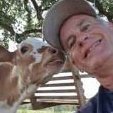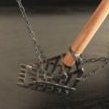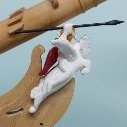-
Posts
3,867 -
Joined
-
Last visited
Reputation Activity
-
 KeithAug reacted to Greg Davis in Santos Dumont No. 18 Hydroplane 1907 by Greg Davis - FINISHED - Scale 1:16
KeithAug reacted to Greg Davis in Santos Dumont No. 18 Hydroplane 1907 by Greg Davis - FINISHED - Scale 1:16
this is dead soft copper, so it bends very easily - to easily in some cases, I believe that is why it damages with little effort. Next I'm going to redo the work using a rod like you suggest.
I had used looping pliers for the first try. The wire notched where it contacted the lower edges of the tool. Some of the nylon faced jewelry equipment might work better with this material.
-
 KeithAug got a reaction from lraymo in Lula by Keith Black - FINISHED - 1:120 Scale - 1870s Sternwheeler Supply Boat for Floating Pile Driver
KeithAug got a reaction from lraymo in Lula by Keith Black - FINISHED - 1:120 Scale - 1870s Sternwheeler Supply Boat for Floating Pile Driver
There does not seem to be any chimney - a steam pipe or two would seem to be the obvious solution - probably using exhaust steam.
-
 KeithAug got a reaction from FriedClams in Lula by Keith Black - FINISHED - 1:120 Scale - 1870s Sternwheeler Supply Boat for Floating Pile Driver
KeithAug got a reaction from FriedClams in Lula by Keith Black - FINISHED - 1:120 Scale - 1870s Sternwheeler Supply Boat for Floating Pile Driver
There does not seem to be any chimney - a steam pipe or two would seem to be the obvious solution - probably using exhaust steam.
-
 KeithAug got a reaction from Canute in Lula by Keith Black - FINISHED - 1:120 Scale - 1870s Sternwheeler Supply Boat for Floating Pile Driver
KeithAug got a reaction from Canute in Lula by Keith Black - FINISHED - 1:120 Scale - 1870s Sternwheeler Supply Boat for Floating Pile Driver
There does not seem to be any chimney - a steam pipe or two would seem to be the obvious solution - probably using exhaust steam.
-
 KeithAug reacted to Keith Black in Lula by Keith Black - FINISHED - 1:120 Scale - 1870s Sternwheeler Supply Boat for Floating Pile Driver
KeithAug reacted to Keith Black in Lula by Keith Black - FINISHED - 1:120 Scale - 1870s Sternwheeler Supply Boat for Floating Pile Driver
In the original photo of Lula, a pilothouse stove is not shown. On most if not all steamboats a pilothouse stove was a necessity "the stove was placed close enough to the wheel to singe the pilot's coattails"
I'm starting to lay out the pilothouse and I have a question, with Lula's pilothouse directly above the engine room, was there enough waste heat from below that with gratings, would there have been enough heat to warm the pilothouse? TYIA.
-
 KeithAug reacted to Keith Black in Lula by Keith Black - FINISHED - 1:120 Scale - 1870s Sternwheeler Supply Boat for Floating Pile Driver
KeithAug reacted to Keith Black in Lula by Keith Black - FINISHED - 1:120 Scale - 1870s Sternwheeler Supply Boat for Floating Pile Driver
Thank you, Keith. Beginners luck me thinks.
Thank you, Lynn. You gave me a smile, TY.
-
 KeithAug got a reaction from bob from barton in Pelican 1943 by FriedClams - 1:48 - Eastern-Rig Dragger
KeithAug got a reaction from bob from barton in Pelican 1943 by FriedClams - 1:48 - Eastern-Rig Dragger
All very beautifully done Gary. Well up to your usual high standard.
You need a teleporter. I have one and it works brilliantly on this type of problem.🙂
-
 KeithAug got a reaction from Canute in Santos Dumont No. 18 Hydroplane 1907 by Greg Davis - FINISHED - Scale 1:16
KeithAug got a reaction from Canute in Santos Dumont No. 18 Hydroplane 1907 by Greg Davis - FINISHED - Scale 1:16
Greg
If the copper is hard soften it by heating (to red) and then quenching - this should make it very easy to bend, then it should be possible just to bend it by hand around a piece of metal rod of appropriate diameter.
-
 KeithAug got a reaction from druxey in Santos Dumont No. 18 Hydroplane 1907 by Greg Davis - FINISHED - Scale 1:16
KeithAug got a reaction from druxey in Santos Dumont No. 18 Hydroplane 1907 by Greg Davis - FINISHED - Scale 1:16
Greg
If the copper is hard soften it by heating (to red) and then quenching - this should make it very easy to bend, then it should be possible just to bend it by hand around a piece of metal rod of appropriate diameter.
-
 KeithAug got a reaction from Glen McGuire in Lula by Keith Black - FINISHED - 1:120 Scale - 1870s Sternwheeler Supply Boat for Floating Pile Driver
KeithAug got a reaction from Glen McGuire in Lula by Keith Black - FINISHED - 1:120 Scale - 1870s Sternwheeler Supply Boat for Floating Pile Driver
The stern wheel looks excellent Keith.
-
 KeithAug got a reaction from Greg Davis in Santos Dumont No. 18 Hydroplane 1907 by Greg Davis - FINISHED - Scale 1:16
KeithAug got a reaction from Greg Davis in Santos Dumont No. 18 Hydroplane 1907 by Greg Davis - FINISHED - Scale 1:16
Greg
If the copper is hard soften it by heating (to red) and then quenching - this should make it very easy to bend, then it should be possible just to bend it by hand around a piece of metal rod of appropriate diameter.
-
 KeithAug reacted to Jim Lad in Lula by Keith Black - FINISHED - 1:120 Scale - 1870s Sternwheeler Supply Boat for Floating Pile Driver
KeithAug reacted to Jim Lad in Lula by Keith Black - FINISHED - 1:120 Scale - 1870s Sternwheeler Supply Boat for Floating Pile Driver
Looking good, Keith!
Re Roel's comments: - I think that we too easily dismiss the skill of the craftsmen of a bygone age. I have a video made quite a while ago of the man who was said to be the last traditionally trained shipwright on the south coast of New South Wales. In the video he was explaining how timber was selected and cut in the bush for boatbuilding at the local yard. He had two different axes with him and using these he cut and shaped timber as it lay on the ground with an accuracy and smoothness that looked like it was done with modern machinery.
John
-
 KeithAug got a reaction from Canute in SMS Karlsruhe by Wreck1919 - 1/100
KeithAug got a reaction from Canute in SMS Karlsruhe by Wreck1919 - 1/100
Really smart and realistic. Excellent.
-
 KeithAug reacted to Keith Black in Lula by Keith Black - FINISHED - 1:120 Scale - 1870s Sternwheeler Supply Boat for Floating Pile Driver
KeithAug reacted to Keith Black in Lula by Keith Black - FINISHED - 1:120 Scale - 1870s Sternwheeler Supply Boat for Floating Pile Driver
Thank you, Gary.
And thank you to everyone for the comments and likes.
This is the last time the interior of the engine room will be visible from above.
Roof added and with that the engine room is done except for the fire bucket boxes and painting.
After posting the photos In my post #276 the engine room's lean toward the bow had to be addressed...much better.
After painting the interior white hopefully it won't be quite so dark.
I didn't want to add maintenance door trim but because quality control was out sick the day they sided the port and starboard walls I had no choice but to add door trim. It's hard finding good help these days
Rudder post added.
I'm tickled pink with the clearances between the wheel and the rudder post and the alignment of the openings for the engine timbers and pitman arms. I was pretty stressed about being able to make that all happen as it should.
Thank you for your support and being part of the journey.
Keith
-
 KeithAug reacted to JacquesCousteau in Lancha Chilota by JacquesCousteau - FINISHED – Scale 1:32 – Chilean Coasting Sloop
KeithAug reacted to JacquesCousteau in Lancha Chilota by JacquesCousteau - FINISHED – Scale 1:32 – Chilean Coasting Sloop
Thanks! Yeah, it's definitely a tricky pattern. It looks like there was some sort of sealant placed over the deck that was bleached by the sun and for some reason only wore off along the center of each plank. Meanwhile the wood that shows through varies from a weathered gray to quite dark (possibly damp patches?). Not to mention the panels of some other material placed aft over the deck. It's also worth noting that written sources agree that lanchas usually just left the deck and hatches in bare, unfinished wood. The Marisol del Carmen was a more recent lancha, though, so presumably they applied something to try to better preserve the wood.
The full photo is interesting as it shows that the white covering wasn't fully applied on the port side. Interestingly, the hatch coaming looks to be bare wood. There are also other details that aren't very clear--I'm not sure what purpose the big rocks have, for instance, they may be holding down the floor mat placed over the deck?
Source: https://www.sigpa.cl/ficha-colectivo/carpinteros-de-ribera-de-lanchas-chilotas
-
 KeithAug reacted to JacquesCousteau in Lancha Chilota by JacquesCousteau - FINISHED – Scale 1:32 – Chilean Coasting Sloop
KeithAug reacted to JacquesCousteau in Lancha Chilota by JacquesCousteau - FINISHED – Scale 1:32 – Chilean Coasting Sloop
Thanks, Bryan! I actually can't say that I fully recommend that anyone follow my path on painting the deck. When applying the successive washes, I came across a problem that I hadn’t encountered on my tests: with all that water, the deck wood expanded and contracted a bit even though it was glued down. As a result, some small gaps opened up in the planking, and the edges of some planks curved up a little bit. I don't think it looks too bad from normal viewing distance, but if you run your finger along the deck, it's noticeable. I think I should have let the deck dry for several hours, or even overnight, between each wash layer. In the future, I may experiment with fewer wash coats and/or using artist's pastels (people like FriedClams have done amazing things with them). Perhaps using thicker deck planks would have helped, as well.
By now, I've mostly painted the lower hull, although I'll likely do some touch-ups and perhaps one last coat later. I've also glued the mast partners and hatch coamings in place, although not the hatch covers yet. I also lightly sanded parts of the deck that would have seen more foot traffic and wear.
Next, the bulwark stanchions are an interesting detail. On many other vessels, the stanchions run through the covering boards and are practically extensions of the frames. In contrast, on most lanchas, the stanchions sit on top of the covering boards, and have a wide base narrowing toward the top. The most common shape was a sort of stepped design, seen below in the vessel in the foreground, but some other designs were also used: see the trapezoidal design on the lancha in the background below, for example.
Source: https://www.bibliotecanacionaldigital.gob.cl/bnd/629/w3-article-164722.html
Another photo showing stepped stanchions:
Source: https://www.carlosvairo.com/galeria-puerto-montt-lanchas-chilotas
While the stepped design was most common, some other designs were also used, such as those below on the Marisol del Carmen supporting a very low bulwark.
Source: https://www.sigpa.cl/ficha-colectivo/carpinteros-de-ribera-de-lanchas-chilotas
The plans I have show stepped stanchions. However, while I'll be following the stepped design, I will need to modify the dimensions a bit. The plans show a 7/32‐inch tall (on the model) bulwark that extends up above the bowsprit, leaving a bit of a gap. However, most photos of lanchas (including those above) show the bowsprit level with the bulwarks or with the cap rail. My bowsprit is made from a 3/16-inch square piece of basswood. So, I'll need to reduce the height of my stanchions to 3/16-inch, something I wish I had realized before preparing 7/32-inch wide strips of 3/32-inch thick scrap wood.
-
 KeithAug reacted to JacquesCousteau in Lancha Chilota by JacquesCousteau - FINISHED – Scale 1:32 – Chilean Coasting Sloop
KeithAug reacted to JacquesCousteau in Lancha Chilota by JacquesCousteau - FINISHED – Scale 1:32 – Chilean Coasting Sloop
Thanks, Keith!
I realized that I forgot to mention that I did end up just placing a black board across the bottom of the hatch interior, to keep the keel assembly out of sight. From a couple angles, if the light is just right, you can see the edge off on the sides--it had to be a bit short to fit into the hatch--but it's practically unnoticeable otherwise. My goal is to suggest that, while there is an interior, it's too shadowy to see any details, adding interest to the build compared with battened-down hatches.
I've also begun painting the hull. Usually you want to start with lighter colors, but in this case the transition will be covered by the as-yet unmade rub rail, and I won't be painting the topsides until I've built the bulwarks. So, black it is for the lower hull. At the moment it looks terrible and uneven, which I've come to understand is what you want in a first coat. Many, many subsequent coats will follow. The final coat(s) will be with a slightly less intense shade of black, but for the base coats, the tint straight from the bottle works fine.
Finally, I've begun looking at some other furnishings. Comparing the plan drawings with photos, some parts--like the bowsprit support--look a little undersized in the plans. I'm less certain about other parts. Does anyone know what a typical rudder thickness for a seagoing, ~30-foot-long boat would be?
-
 KeithAug got a reaction from eatcrow2 in SMS Karlsruhe by Wreck1919 - 1/100
KeithAug got a reaction from eatcrow2 in SMS Karlsruhe by Wreck1919 - 1/100
Really smart and realistic. Excellent.
-
 KeithAug got a reaction from AON in Santos Dumont No. 18 Hydroplane 1907 by Greg Davis - FINISHED - Scale 1:16
KeithAug got a reaction from AON in Santos Dumont No. 18 Hydroplane 1907 by Greg Davis - FINISHED - Scale 1:16
Greg
If the copper is hard soften it by heating (to red) and then quenching - this should make it very easy to bend, then it should be possible just to bend it by hand around a piece of metal rod of appropriate diameter.
-
 KeithAug reacted to Greg Davis in Santos Dumont No. 18 Hydroplane 1907 by Greg Davis - FINISHED - Scale 1:16
KeithAug reacted to Greg Davis in Santos Dumont No. 18 Hydroplane 1907 by Greg Davis - FINISHED - Scale 1:16
This is my first try at making the fuel distribution system - two copies are needed. I drilled 4 holes through the center copper piece, soldered and then bent the distribution pipes. I think I can improve on this trial a bit, but most importantly, I hope that it looks a bit more like what was on the hydroplane than the castings that came with the engine kits (see pic of the V8 from my 14bis build below). The copper seems to be about the right diameters, but the bends need to be done without so much damage to the wire.
-
 KeithAug reacted to Greg Davis in Santos Dumont No. 18 Hydroplane 1907 by Greg Davis - FINISHED - Scale 1:16
KeithAug reacted to Greg Davis in Santos Dumont No. 18 Hydroplane 1907 by Greg Davis - FINISHED - Scale 1:16
The remaining painting of the cylinders was completed and now they are attached to the engine block. It is really starting to grow (and get heavy). I think the fueling system needs to be worked out next.
-
 KeithAug reacted to mcb in Blairstown by mcb - 1:160 - PLASTIC - Steam Derrick Lighter NY Harbor
KeithAug reacted to mcb in Blairstown by mcb - 1:160 - PLASTIC - Steam Derrick Lighter NY Harbor
Hello All,
Thank You to Keith Black, Canute, Fried Clams and Wintergreen for your comments and thanks to all for the likes.
Here is a brief report as this build moves slowly along.
The rear derrick legs are built up and resting temporarily in the fixture. I will now have to build the three sets of cross braces between the front and rear legs. All these legs and cross braces are of different sizes and constructions. I hope that it will be apparent in the final product.
Before long I should check clearance on the actual model, so I don't have any nasty surprises.
Last night I brushed the front leg assembly knocking it over gently onto the cutting mat. One of the guide sheaves went flying to the floor, I was an hour finding it. At least I don't have to make another.
Thanks for Looking in,
mcb
-
 KeithAug reacted to mcb in Blairstown by mcb - 1:160 - PLASTIC - Steam Derrick Lighter NY Harbor
KeithAug reacted to mcb in Blairstown by mcb - 1:160 - PLASTIC - Steam Derrick Lighter NY Harbor
Hello All,
Thanks for the comments, Wintergreen, Keith Black, Jim Lad and Canute. Thanks everyone for the likes.
I just want to put up a pic of where things are now on the forward derrick leg.
I mounted the pivoting guide sheaves (3 larger and 2 smaller) high up on the derrick. I am not sure of the proper name for these, please correct me if I am wrong.
I also put rivets on the gusset plates, I think they will look alright after paint, and I will be using more on the remaining parts of the derrick and boom.
After viewing the latest pictures, I see more touch up, clean-up and corrections are needed.
Thanks for looking,
mcb
-
 KeithAug reacted to Ian_Grant in HMS Lion by Ian_Grant - 1/150 - RADIO - RESTORATION - WW1 Battlecruiser
KeithAug reacted to Ian_Grant in HMS Lion by Ian_Grant - 1/150 - RADIO - RESTORATION - WW1 Battlecruiser
Lead shot ballast added according to the results of the flotation tank test (why is it "float" but "flotation"?). Compartments with lead were "capped" internally to stop lead from shifting around. Foredeck added. Before adding aft deck I needed to get "X" turret rotation sorted. Here's a quick video of the four turrets rotating together. Now I can add the aft deck and get going on the aft superstructure.
I am now working on printed additions for the turrets, which fix the turret fronts which dipped a little low, and add the three sighting hoods. There's also a hatch or something shown on the drawings at the top rear of all turrets except "A". Not sure what they are as they seem too low to be rangefinders, and are asymmetrical from side to side. (??)
The 3D rendering has imaginative apparent rangefinders here but this is not in the photos of Lion in my book, even in 1918 after wartime modifications.
Also need to decide whether gun barrel holes need to be plugged and re-drilled slightly higher.
HMS Lion Turret Rotation.mp4
-
 KeithAug reacted to FriedClams in Pelican 1943 by FriedClams - 1:48 - Eastern-Rig Dragger
KeithAug reacted to FriedClams in Pelican 1943 by FriedClams - 1:48 - Eastern-Rig Dragger
Hey Keith, now that's an idea! Wonder if I can find a used one somewhere?
Yes Druxey, AutoCAD has been known to have that effect on people.
I use DesignCAD for my 2D drawing and have for decades, but for 3D modeling I prefer FreeCAD over it and a number of other alternatives. I think it's a very good solid modeler and a decent surface modeler. There are many good "free to use" programs, but with FreeCAD you download it once and its yours forever; no logging on to a website, registering or having to use it in the cloud. And no concerns that after investing the time to learn a program, the company granting you free access might change the rules and make you a subscriber or a previous user. FreeCAD certainly has its quirks and weaknesses, but so do the alternatives. And I'm not a power user - I just want to make a few parts for my models.
Extensive online tutorials and help is available. I found YouTuber MangoJelly Solutions to be a great help.
Be safe everyone and stay well. Hope to have a Pelican update this week.
Gary







